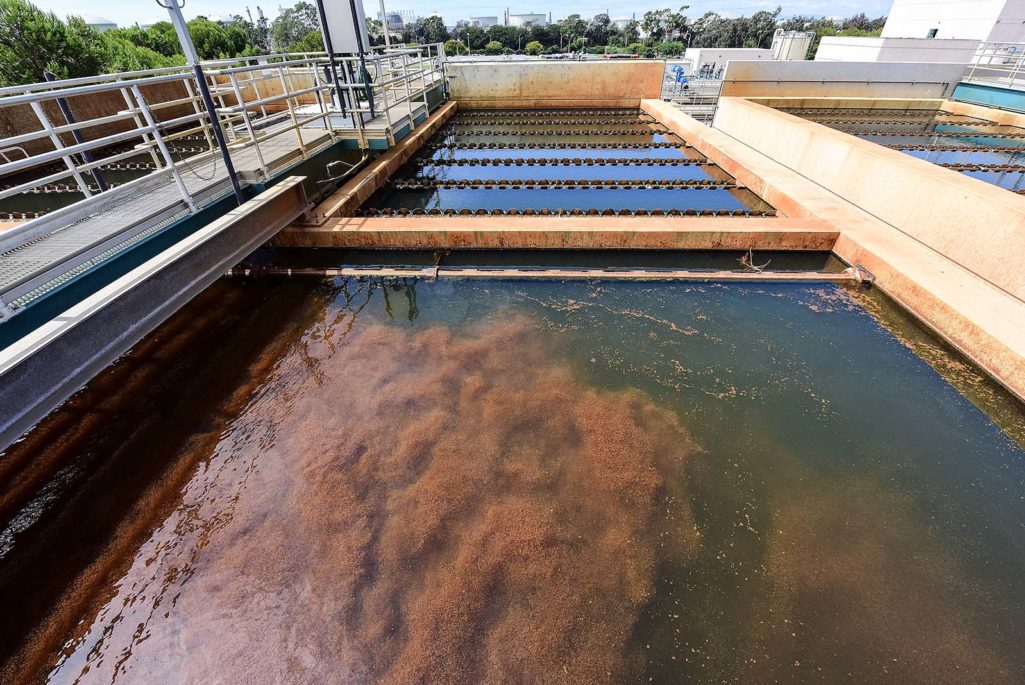Using Less Energy to Treat Water Can Deliver a Deluge of Savings

A brown coagulate is added to waste water to remove solids in the preliminary stage of recycling at the West Basin Municipal Water District water recycling facility in El Segundo, California, September 14, 2015. The finished product is sent underground to replenish the areas aquifers where it mixes with the natural underground water supply which feeds wells. Critics call the method toilet to tap but the final product is more pure than tap or bottled water and exceeds all state and federal drinking water standards.
Photo: Robyn Beck/AFP/Getty Images
[Perspectives on Innovation: Part of our regular monthly series featuring content from Perspectives on GE Reports.]
Let’s talk about water.
There are big energy opportunities that come from innovative thinking about water usage, particularly given that much of the Western world’s infrastructure is not set up in such a way that wastewater is reused and recycled.
Consider some key statistics:
- 16 percent of the U.S. water supply is lost, going back into the ground due to leaky pipes.
- Only 7 percent of U.S. communities recycle wastewater.
- In Israel, more than 80 percent of household wastewater is recycled, with half of that going to irrigation.
Bottom line for the U.S.? Utilities lose enough water every six days to supply the nation for a day.
That infrastructure challenge of wasted water exists for many Western nations. Canada is one of the highest per capita users of water on the planet. The average person there generates 300 liters of wastewater per day, compared to 20 to 30 liters in developing countries. Other developed countries show similar patterns.
That doesn’t have to be the case if strategies are adopted to more aggressively recycle “gray water ” within a community. What’s gray water? Quite simply, it’s the water we send down the drain from showers, toilets, sinks and other commercial and residential sources. Most of it disappears, draining into oceans, lakes or ground aquifers.
Utilities lose enough water every six days to supply the nation for a day.
What if we could recycle that water and reuse it, and thus engage some of the expense of moving so much other water around?
Consider the Irvine Ranch Water District in California, which has had a recycled water program since 1961, serving areas such as Newport Beach and parts of Orange County. The results are impressive: Recycled water meets some 21 percent of the area’s water demands. While initially aimed at water use for agriculture, it now provides services for landscape irrigation, industrial use and toilet flushing in commercial buildings. The system now delivers 23.5 million gallons of recycled water to more than 4,000 customers daily.
This is while water supply and access are becoming increasing challenges in many areas of the world.
In California, the energy cost of water is particularly expensive. In an article in The American Journal of Public Health, some of the numbers are pretty clear:
- Pumping, treating, transporting and heating California’s water currently represent nearly 20 percent of the state’s energy use.
- Much of this energy use is the result of a heavy reliance on imported water, because the majority of California’s water users are concentrated far from major water sources.
- Transporting water via California’s State Water Project—the state-built water delivery and storage system—is 2 to 3 percent of the state’s total energy alone and results in roughly 4 million tons of greenhouse gas emissions per year.
The potential energy savings are huge if more recycled gray water is utilized.
The potential energy savings are huge if more recycled gray water is utilized. If 10 percent of imported water in California was replaced by recycled water, there would be a savings of 80 million kWh of energy annually.
It is estimated that some 9 percent of U.S. carbon emissions are related to transporting water, and that heating water totals 58 percent of the national energy footprint of water usage.
That’s why the gray water opportunity is clear.
One of the companies using technology to deal with the challenge is Nexus eWater. It markets itself as the world’s first home water and energy recycler, providing a solution for residential water reuse. Nexus has some pretty bold goals that can be met utilizing its system:
- Reducing city water into the home by up to 40 percent
- Reducing sewage from the home by 70 percent
- Reducing water heating energy by 70 percent
- Generating total savings of $50 to $200 per month per home for water, sewer and electric bills, at least for the River Islands community in Lathrop, California
- Harvesting rainwater
How does it work? With advanced filtering and energy capture technologies, they provide recycled water of a quality that is safe to use on lawns and in toilets. In addition, they can capture the heat in gray water, and thus produce hot water using 75 percent less energy than that from the electrical grid. The cost? Currently, at least $10,000 per home.
Nexus is just one such initiative. ReWater Systems, also based in California, offers a gray water solution that reuses sink, toilet, shower and other residential water for lawn and garden irrigation. Spend some time on crowdfunding sites like Kickstarter and you can find all kinds of initiatives geared towards the idea.
There are plans to develop communities that employ efficient recycled water systems. The Sea Cliff community, under construction in San Diego, is specifically built with this purpose in mind. It is estimated that each of the 52 upscale homes there will save up to 100,000 gallons of water per year.
It’s clear there are leaders who are looking at this problem as an opportunity. I’d hazard a guess that this will be a pretty big growth market in the years to come.
What should you do? As I suggest with any new area of opportunity, you should “think big, start small and scale fast.” Gain some inspiration from the many initiatives in this area and maybe take on a pilot gray water program. Learn from your efforts and then determine how to go further, either from a simple residential project or an overall community initiative.
This piece first appeared in Perspectives on GE Reports.




